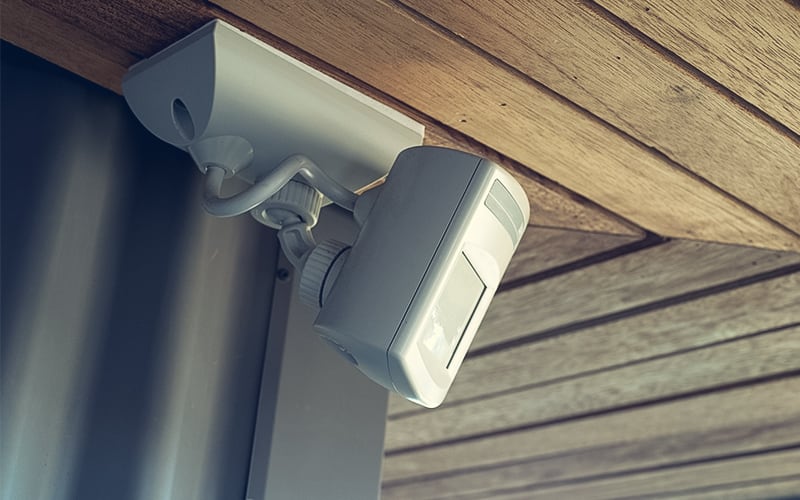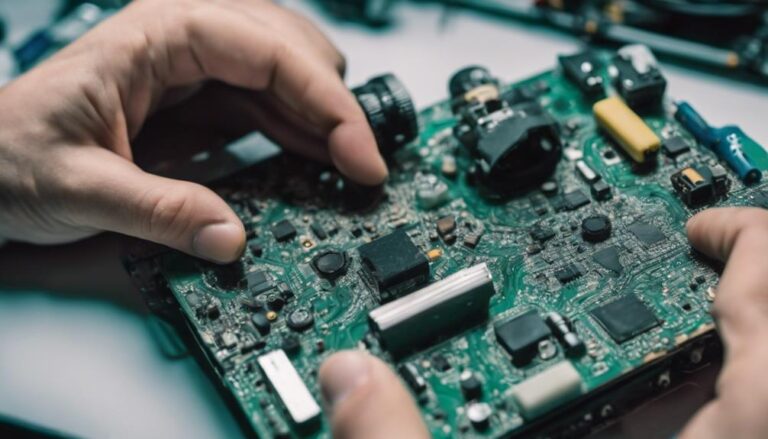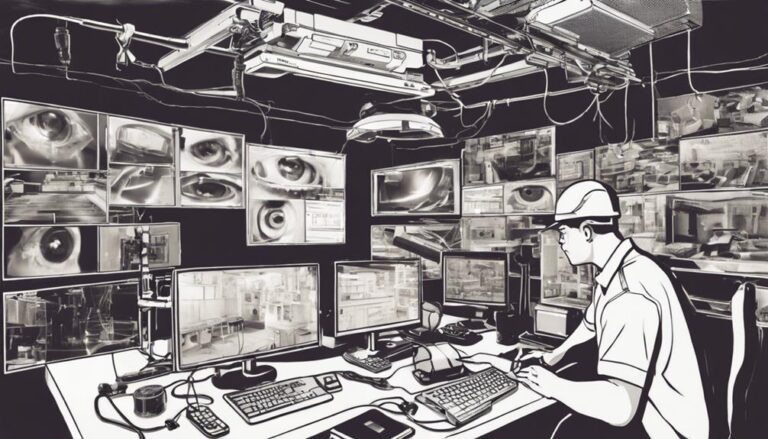Yes, some motion detectors do have cameras. These integrated units combine movement detection with video surveillance to help boost security. Traditional motion detectors sense movement through infrared, ultrasonic, or microwave signals, but motion detector cameras go a step further by capturing images or video when they detect motion. This setup helps you monitor areas more effectively and can offer a sense of added security. They’re ideal for home or business use and are compatible with smart home systems for remote monitoring. For more detailed info, you’ll find focus areas that cover installation tips and privacy concerns.
Understanding Motion Detectors
Understanding motion detectors involves knowing how they sense movement and trigger alerts. These devices have a history overview that’s pretty fascinating. Imagine a time when protecting your space meant relying solely on physical barriers. Fast forward to today, and you’ve got advanced technology guarding your freedom and privacy.
The basic principles of motion detectors are straightforward yet ingenious. They sense movement by detecting changes in their environment. This could be through infrared energy, ultrasonic waves, or even microwave signals. When a motion detector notices a change, it triggers an alert, letting you know something’s up. It’s like having a vigilant guardian that never sleeps.
Motion detectors began as simple mechanisms used in the early 20th century. The initial designs were rudimentary but laid the groundwork for the sophisticated systems we have now. Over the decades, innovation has transformed these early prototypes into highly sensitive and reliable devices.
You don’t want to feel trapped or restricted, and motion detectors offer a way to maintain your freedom while ensuring your safety. Understanding how these devices work can empower you to make informed choices about securing your space.
Types of Motion Detectors
When you’re considering motion detectors with cameras, it’s essential to understand the different types available. Passive Infrared Sensors, Ultrasonic Motion Detectors, and Microwave Motion Sensors each have unique features and benefits. Let’s explore how these options can enhance your security setup.
Passive Infrared Sensors
Among the various types of motion detectors, passive infrared sensors (PIR) stand out for their reliability and effectiveness in detecting movement through heat signatures. These sensors work by picking up infrared radiation emitted by warm bodies, such as humans and animals. When a warm body moves within the sensor’s field of view, the change in infrared radiation triggers the sensor, alerting you to potential movement.
PIR sensors offer several benefits that make them a great choice for those who value freedom and security:
- Non-intrusive: Unlike some motion detectors, PIR sensors don’t emit any signals, making them less likely to interfere with other devices.
- Energy-efficient: They use minimal power, which means you can rely on them without worrying about frequent battery changes.
- Cost-effective: Generally, they’re more affordable than other types of motion detectors.
- Wide coverage: PIR sensors can cover large areas, providing extensive surveillance with fewer units.
- Longevity: These sensors are durable and tend to have a long operational life.
With their ability to detect heat through infrared radiation, PIR sensors provide a dependable solution for monitoring movement without compromising your sense of freedom. They’re an excellent choice for safeguarding your space while ensuring minimal disruption to your everyday life.
Ultrasonic Motion Detectors
Unlike PIR sensors, ultrasonic motion detectors use sound waves to detect movement within a given area. Imagine the freedom of knowing that your security system can “hear” what’s happening even in the dark or through obstructions. These detectors emit ultrasonic waves, which are sound waves at frequencies higher than human hearing. When these waves hit an object, they bounce back to the sensor.
Here’s where it gets interesting: the detector measures the time it takes for the waves to return and the changes in frequency caused by movement. This is known as the Doppler effect. If someone or something moves within the monitored area, the frequency of the returning waves changes, triggering the detector.
You’ll appreciate the versatility of ultrasonic motion detectors. They can cover large areas and aren’t affected by temperature changes or light conditions. Plus, they can detect motion through soft materials like curtains, giving you peace of mind in various environments. However, they do have limitations, like being susceptible to interference from other ultrasonic sources. Understanding these nuances helps you make an informed decision, giving you the liberty to choose the best security setup for your needs.
Microwave Motion Sensors
Microwave motion sensors offer a range of benefits that make them worth exploring. They utilize electromagnetic waves to detect movement, providing reliable performance even through walls and other solid objects. These sensors are perfect if you’re looking for a system that doesn’t rely on line-of-sight. They operate by emitting microwave signals and measuring the reflection of these waves to detect motion.
Here’s why you’d want to explore microwave motion sensors:
- Penetration Power: They can detect movement through walls, doors, and other barriers.
- Reduced False Alarms: Less prone to false triggers from environmental changes compared to other types.
- Adjustable Sensitivity: You can tweak the motion frequencies to suit your specific needs.
- Versatile Applications: Ideal for both indoor and outdoor settings.
- Minimal Sensor Interference: Typically experiences low interference from other electronic devices.
One of the key advantages is their ability to work in varied conditions, making them a fit for those who value freedom and flexibility in security setups. However, be aware of potential sensor interference from other microwave devices, which can affect performance. By carefully adjusting the motion frequencies, you can mitigate these issues and enjoy a robust security solution.
Motion Detectors Vs. Cameras
When comparing motion detectors and cameras, you’ll notice key differences in their detection mechanisms, privacy implications, and ease of installation. Motion detectors rely on sensing movement, whereas cameras provide visual monitoring. It’s important to weigh these factors based on your specific needs and concerns.
Detection Mechanism Comparison
Comparing the detection mechanisms of motion detectors and cameras reveals distinct advantages and limitations for each technology. Motion detectors primarily use infrared sensors to detect heat and movement, making them highly energy efficient. They typically have a broad detection range, ensuring that even minimal motion triggers an alert. Cameras, on the other hand, provide visual confirmation, capturing images or video when motion is detected. While cameras offer detailed context, they can consume more power and may have a limited detection range compared to motion detectors.
Here are some key points to keep in mind:
- Detection Range: Motion detectors usually cover a wider area, while cameras focus on a specific field of view.
- Energy Efficiency: Motion detectors consume less power, perfect for those looking to minimize energy usage.
- Functionality: Cameras capture visual evidence, but motion detectors are better at detecting subtle movements.
- Installation: Motion detectors are generally simpler to install and require less maintenance.
- Cost: Motion detectors are often more affordable, making them a budget-friendly option for many.
Both technologies have their merits depending on your needs. If you prioritize energy efficiency and a broad detection range, motion detectors might be your best bet. Conversely, if capturing visual evidence is essential, cameras are the way to go.
Privacy Concerns Addressed
While both motion detectors and cameras offer distinct advantages, it’s important to contemplate the privacy implications of each technology. Motion detectors, with their motion sensitivity and light triggers, are less invasive than cameras. They simply detect movement and activate lights or alarms, providing security without constantly recording or monitoring your activities. This allows you to maintain your freedom and privacy while still ensuring safety.
In contrast, cameras capture and store visual data, which can feel intrusive. Even when aimed at public areas, cameras often record private moments inadvertently. If you value your personal space and freedom from constant surveillance, motion detectors might be a more suitable choice. They alert you to movement without creating a digital footprint of your daily life.
Moreover, motion detectors can be strategically placed to cover specific zones, activating only when necessary. This tailored approach respects your privacy more than a camera that records continuously. By choosing motion detectors with light triggers, you gain the advantage of immediate awareness without compromising the sanctity of your personal environment. Ultimately, the choice between motion detectors and cameras hinges on your comfort level with surveillance and your desire for privacy.
Installation and Usage
Installing motion detectors is generally quicker and more straightforward than setting up cameras. You don’t have to worry about finding the perfect angle or dealing with complicated wiring. Instead, you can place motion detectors in strategic spots and be done in minutes. Here are some installation tips and usage scenarios to help you decide what’s best for your space:
- Ease of Setup: Motion detectors often just need a few screws or adhesive mounts, while cameras can require more complex installation.
- Coverage: A single motion detector can cover a wide area, making it ideal for large spaces or high-traffic zones.
- Power Options: Many motion detectors run on batteries, offering you flexibility in placement without needing power outlets.
- Privacy: If you’re concerned about constant monitoring, motion detectors can alert you to movement without capturing video.
- Cost-Effective: Motion detectors are generally cheaper than cameras, making them an affordable option for security.
Usage scenarios vary depending on your needs. Use motion detectors to secure entry points or hallways, while cameras are better for detailed monitoring of specific areas. Decide what aligns with your lifestyle and enjoy the peace of mind that comes with a well-secured space.
Integrated Motion Detector Cameras
Integrated motion detector cameras offer a seamless blend of surveillance and motion detection, providing enhanced security for your home or business. With their integrated functionality, these devices combine the best of both worlds, guaranteeing you don’t need separate systems for motion detection and video surveillance. Technological advancements have made these units more compact and efficient, allowing for easy installation and minimal maintenance, so you can enjoy peace of mind without being bogged down by complex setups.
You’ll love the freedom these devices offer. Imagine not having to worry about false alarms or missed events. Integrated motion detector cameras are designed to capture only relevant activity, filtering out unnecessary footage. This means you’ll get alerts only when it truly matters, freeing you from constant monitoring. Plus, with features like night vision and high-definition recording, you’ll be able to keep an eye on things 24/7, no matter the lighting conditions.
These systems are also often compatible with smart home technologies, allowing you to control and monitor your security setup remotely. This added layer of convenience ensures you’re always in control, whether you’re at home or on the go.
Privacy Concerns and Solutions
Despite their myriad benefits, motion detector cameras do raise valid privacy concerns that require addressing. When you install a device that continuously monitors movements, you’re basically placing a digital eye within your personal or professional space. This can have significant privacy implications, particularly if the data captured falls into the wrong hands.
To guarantee your freedoms aren’t compromised, consider these crucial points:
- Data Encryption: Always opt for devices that offer end-to-end encryption. This guarantees that the video feed is protected from unauthorized access.
- User Control: Look for systems that give you full control over who can view the footage. You should be able to easily manage permissions.
- No Cloud Storage: Choose devices that store data locally rather than on the cloud. This minimizes the risk of breaches.
- Regular Updates: Ensure the firmware is consistently updated to protect against vulnerabilities.
- Clear Guidelines: Establish clear guidelines on where and how these cameras can be used to respect everyone’s privacy.
Choosing the Right Security System
When choosing the appropriate security system, it’s crucial to consider factors like compatibility, ease of installation, and the level of support provided. You don’t want to be stuck with a complicated setup that requires professional help every time something goes wrong. Look for systems that offer straightforward installation and clear instructions, so you can get it up and running without hassle.
Another critical factor is system maintenance. Opt for a security system that doesn’t require constant upkeep. Regular updates and minimal manual intervention should be the norm, allowing you to focus on living your life without frequent interruptions. Reliable customer support can also make a world of difference, especially if you run into issues that need troubleshooting.
Don’t forget to check user reviews. Real-world experiences from other users can provide valuable insights that you won’t find in the product description. Reviews can reveal potential problems or highlight benefits you hadn’t considered, helping you make a more informed decision.
Ultimately, the right security system should offer peace of mind without chaining you down with complexity or excessive maintenance. Choose wisely, and enjoy the freedom that comes with knowing you’re protected.
Frequently Asked Questions
How Do Motion Detectors Differentiate Between Pets and Intruders?
Motion detectors use infrared sensors to detect heat. With pet immunity, they’re designed to ignore smaller heat signatures from pets, letting you enjoy your freedom without worrying about false alarms from your furry friends.
Can Motion Detectors Work Effectively in Outdoor Environments?
Yes, motion detectors can work effectively outdoors. Look for models with solar power and good battery life, ensuring they’re reliable and low-maintenance. You’ll enjoy more freedom without worrying about constant recharging or power issues.
What Is the Typical Range of a Motion Detector?
Did you know most motion detectors have a detection range of 50-80 feet? Depending on the sensor types, they can cover large areas, giving you the freedom to secure your space without feeling confined.
Are Motion Detectors Susceptible to False Alarms?
Yes, motion detectors can be susceptible to false alarms. If the sensor calibration isn’t precise or there’s lighting interference, you might experience unnecessary alerts. Ensuring proper setup will give you the freedom to move worry-free.
How Do Weather Conditions Affect Motion Detector Performance?
Imagine the freedom of a flawless system. Weather conditions like rain or fog can impact motion detectors by causing environmental interference. Proper sensor calibration is essential to minimize false alarms and guarantee peak performance regardless of the elements.



